This is an old revision of this page, as edited by Rezameyqani (talk | contribs) at 12:05, 20 March 2018 (Assisted by Citation bot). The present address (URL) is a permanent link to this revision, which may differ significantly from the current revision.
Revision as of 12:05, 20 March 2018 by Rezameyqani (talk | contribs) (Assisted by Citation bot)(diff) ← Previous revision | Latest revision (diff) | Newer revision → (diff)Award
| Abel Prize | |
|---|---|
 | |
| Description | Outstanding scientific work in the field of mathematics |
| Country | Norway |
| Presented by | Government of Norway |
| First awarded | 2003 |
| Website | www.abelprize.no |
The Abel Prize /ˈɑːbəl/ (Template:Lang-no) is a Norwegian prize awarded annually by the Government of Norway to one or more outstanding mathematicians. Named after Norwegian mathematician Niels Henrik Abel (1802–1829) and modelled after the Nobel Prizes, the award was established in 2001 by the Government of Norway and complements its sister prize in the humanities, the Holberg Prize. It comes with a monetary award of 6 million Norwegian kroner (NOK) (around €650,000). According to a reputation survey conducted in 2013 and 2014, it is the most prestigious international academic award in mathematics.
The award ceremony takes place in the Atrium of the University of Oslo Faculty of Law, where the Nobel Peace Prize was awarded between 1947 and 1989. The Abel Prize board has also established an Abel symposium, administered by the Norwegian Mathematical Society.
History
The prize was first proposed in 1902, to be part of the celebration of 100th anniversary of Abel's birth. Shortly before his death in 1899, the Norwegian mathematician Sophus Lie proposed establishing an Abel Prize when he learned that Alfred Nobel's plans for annual prizes would not include a prize in mathematics. King Oscar II was willing to finance a mathematics prize in 1902, and the mathematicians Ludwig Sylow and Carl Størmer drew up statutes and rules for the proposed prize. However, Lie's influence waned after his death, and the dissolution of the union between Sweden and Norway in 1905 ended the first attempt to create the Abel Prize.

After interest in the concept of the prize had risen in 2001, a working group was formed to develop a proposal, which was presented to the Prime Minister of Norway in May. In August 2001, the Norwegian government announced that the prize would be awarded beginning in 2002, the two-hundredth anniversary of Abel's birth. Atle Selberg received an honorary Abel Prize in 2002, but the first actual Abel Prize was only awarded in 2003.
A book series presenting Abel Prize laureates and their research was commenced in 2010. The first two volumes cover the years 2003–2007 and 2008–2012 respectively.
Selection criteria
The Norwegian Academy of Science and Letters declares the winner of the Abel Prize each March after recommendation by the Abel Committee, which consists of five leading mathematicians. The committee is currently headed by John Rognes. The International Mathematical Union and the European Mathematical Society nominate members of the Abel Committee. The Norwegian Government gave the prize an initial funding of NOK 200 million (about €21.7 million) in 2001. The funding is controlled by the Board, which consists of members elected by the Norwegian Academy of Science and Letters.
Anyone may submit a nomination, but self-nomination is not allowed. The nominee must be alive; however, if the awardee dies after being declared as the winner, the prize is awarded posthumously. The Abel Prize laureate is decided by the Norwegian Academy of Science and Letters based on the recommendation of the Abel Committee. Both Norwegians and non-Norwegians may serve on the Committee; they are elected by the Norwegian Academy of Science and Letters and nominated by the International Mathematical Union and the European Mathematical Society.
Laureates
| Year | Laureate(s) | Image | Citizenship(s) | Institution(s) | Citation |
|---|---|---|---|---|---|
| 2003 | Jean-Pierre Serre | 
|
Collège de France | "For playing a key role in shaping the modern form of many parts of mathematics, including topology, algebraic geometry and number theory." | |
| 2004 | Michael Atiyah | 
|
University of Edinburgh | "For their discovery and proof of the index theorem, bringing together topology, geometry and analysis, and their outstanding role in building new bridges between mathematics and theoretical physics." | |
| Isadore Singer | 
|
Massachusetts Institute of Technology | |||
| 2005 | Peter Lax | 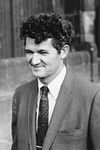
|
Courant Institute | "For his groundbreaking contributions to the theory and application of partial differential equations and to the computation of their solutions." | |
| 2006 | Lennart Carleson | 
|
Royal Institute of Technology | "For his profound and seminal contributions to harmonic analysis and the theory of smooth dynamical systems." | |
| 2007 | S. R. Srinivasa Varadhan | 
|
Courant Institute | "For his fundamental contributions to probability theory and in particular for creating a unified theory of large deviation." | |
| 2008 | John G. Thompson | 
|
University of Florida | "For their profound achievements in algebra and in particular for shaping modern group theory." | |
| Jacques Tits | 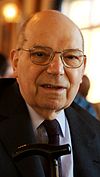
|
Collège de France | |||
| 2009 | Mikhail Gromov | 
|
Institut des Hautes Études Scientifiques and Courant Institute | "For his revolutionary contributions to geometry." | |
| 2010 | John Tate | 
|
University of Texas at Austin | "For his vast and lasting impact on the theory of numbers." | |
| 2011 | John Milnor | 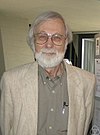
|
Stony Brook University | "For pioneering discoveries in topology, geometry, and algebra." | |
| 2012 | Endre Szemerédi | 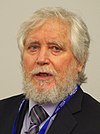
|
Alfréd Rényi Institute and Rutgers University |
"For his fundamental contributions to discrete mathematics and theoretical computer science, and in recognition of the profound and lasting impact of these contributions on additive number theory and ergodic theory." | |
| 2013 | Pierre Deligne | 
|
Institute for Advanced Study | "For seminal contributions to algebraic geometry and for their transformative impact on number theory, representation theory, and related fields." | |
| 2014 | Yakov Sinai | 
|
Princeton University and Landau Institute for Theoretical Physics | "For his fundamental contributions to dynamical systems, ergodic theory, and mathematical physics." | |
| 2015 | John F. Nash Jr. | 
|
Princeton University | "For striking and seminal contributions to the theory of nonlinear partial differential equations and its applications to geometric analysis." | |
| Louis Nirenberg | 
|
Courant Institute | |||
| 2016 | Andrew Wiles | 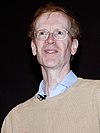
|
University of Oxford | "For his stunning proof of Fermat's Last Theorem by way of the modularity conjecture for semistable elliptic curves, opening a new era in number theory." | |
| 2017 | Yves Meyer | 
|
École normale supérieure Paris-Saclay | "For his pivotal role in the development of the mathematical theory of wavelets." | |
| 2018 | Robert Langlands | 
|
Institute for Advanced Study | "For his visionary program connecting representation theory to number theory. |
See also
References
- "Statutter for Holbergprisen og Nils Klim-prisen".
- Dreifus, Claudia (29 March 2005). "From Budapest to Los Alamos, a Life in Mathematics". The New York Times.
- Cipra, Barry A. (26 March 2009). "Russian Mathematician Wins Abel Prize". ScienceNOW. Archived from the original on 29 March 2009. Retrieved 29 March 2009.
{{cite web}}: Unknown parameter|deadurl=ignored (|url-status=suggested) (help) - "Geometer wins maths 'Nobel'". Nature. 26 March 2009. Retrieved 17 October 2012.
- Foderaro, Lisa W. (31 May 2009). "In N.Y.U.'s Tally of Abel Prizes for Mathematics, Gromov Makes Three". The New York Times. Retrieved 17 October 2012.
- "Abel Prize Awarded: The Mathematicians' Nobel". The Mathematical Association of America. April 2004. Archived from the original on 27 August 2012. Retrieved 4 November 2012.
{{cite web}}: Unknown parameter|deadurl=ignored (|url-status=suggested) (help) - Piergiorgio Odifreddi; Arturo Sangalli (2006). The Mathematical Century: The 30 Greatest Problems of the Last 100 Years. Princeton University Press. p. 6. ISBN 0-691-12805-7.
- "Google Currency Converter". Retrieved 27 March 2017.
- IREG Observatory on Academic Ranking and Excellence. IREG List of International Academic Awards (PDF). Brussels: IREG Observatory on Academic Ranking and Excellence. Retrieved 3 March 2018.
- Zheng, Juntao; Liu, Niancai (2015). "Mapping of important international academic awards". Scientometrics. 104: 763–791. doi:10.1007/s11192-015-1613-7.
- "University of Oslo". Oslo Opera House. Retrieved 22 December 2012.
- "Main Page". The Norwegian Academy of Science and Letters. Retrieved 26 July 2012.
- ^ "The History of the Abel Prize". The Norwegian Academy of Science and Letters. Retrieved 26 July 2012.
- O'Connor, John J.; Robertson, Edmund F., "Atle Selberg", MacTutor History of Mathematics Archive, University of St Andrews
- H. Holden; R. Piene, eds. (2010). The Abel Prize 2003–2007. Heidelberg: Springer. doi:10.1007/978-3-642-01373-7. ISBN 978-3-642-01372-0.
- H. Holden; R. Piene, eds. (2014). The Abel Prize 2008–2012. Heidelberg: Springer. doi:10.1007/978-3-642-39449-2. ISBN 978-3-642-39449-2.
- "The Abel Committee 2015/2016". Retrieved 4 January 2016.
- "Google Currency Converter". Retrieved 27 March 2017.
- ^ "Nomination Guidelines". The Norwegian Academy of Science and Letters. Retrieved 26 July 2012.
- "The Abel Prize Laureate 2003". The Norwegian Academy of Science and Letters. Retrieved 23 December 2012.
- "The Abel Prize Laureate 2004". The Norwegian Academy of Science and Letters. Retrieved 23 December 2012.
- "Peter Lax | Simons Foundation". Simons Foundation. Retrieved 12 November 2015.
- "The Abel Prize Laureate 2005". The Norwegian Academy of Science and Letters. Retrieved 23 December 2012.
- "Swedish mathematician receives the Abel Prize". The Norwegian Academy of Science and Letters. Retrieved 23 December 2012.
- "The Abel Prize Laureate 2006". The Norwegian Academy of Science and Letters. Retrieved 23 December 2012.
- "Fields Institute – Thematic Program on Dynamic and Transport in Disordered Systems". Fields Institute for Research in Mathematical Sciences. Retrieved 23 December 2012.
- "The Abel Prize Laureate 2007". The Norwegian Academy of Science and Letters. Retrieved 23 December 2012.
- "The Abel Prize Laureate 2008". The Norwegian Academy of Science and Letters. Retrieved 23 December 2012.
- "Abel Prize Ceremony 2008". The Royal Norwegian Embassy in Seoul. Retrieved 23 December 2012.
- "Russian-French mathematician receives the Abel Prize". The Norwegian Academy of Science and Letters. Retrieved 23 December 2012.
- "The Abel Committee's Citation 2009". The Norwegian Academy of Science and Letters. Retrieved 9 August 2016.
- Foderaro, Lisa W. (31 May 2009). "In N.Y.U.'s Tally of Abel Prizes for Mathematics, Gromov Makes Three". The New York Times. Retrieved 17 October 2012.
- "The Abel Prize Laureate 2009". The Norwegian Academy of Science and Letters. Retrieved 9 August 2016.
- "The Abel Prize Laureate 2010". The Norwegian Academy of Science and Letters. Retrieved 23 December 2012.
- "Dimension-Cruncher: Exotic Spheres Earn Mathematician John Milnor an Abel Prize". Scientific American. Retrieved 23 December 2012.
- "The Abel Prize Laureate 2011". The Norwegian Academy of Science and Letters. Retrieved 23 December 2012.
- "Hungarian-American Endre Szemerédi named Abel Prize winner". The Norwegian Academy of Science and Letters. Retrieved 23 December 2012.
- "The Abel Prize Laureate 2012". The Norwegian Academy of Science and Letters. Retrieved 23 December 2012.
- "The Abel Prize Laureate 2013". The Norwegian Academy of Science and Letters. Retrieved 20 June 2013.
- "The Abel Committee's Citation 2014". The Norwegian Academy of Science and Letters. Retrieved 9 August 2016.
- "The Abel Prize Laureate 2014". The Norwegian Academy of Science and Letters. Retrieved 26 March 2014.
- "The Abel Prize Laureates 2015". The Norwegian Academy of Science and Letters. Retrieved 9 August 2016.
- "The Abel Committee's Citation 2016". The Norwegian Academy of Science and Letters. Retrieved 9 August 2016.
- "Sir Andrew J. Wiles receives the Abel Prize" (Press release). The Norwegian Academy of Science and Letters. Retrieved 9 August 2016.
- "The Abel Prize Laureate 2016". The Norwegian Academy of Science and Letters. Retrieved 15 March 2016.
- "The Abel Prize Laureate 2017". The Norwegian Academy of Science and Letters. Retrieved 21 March 2017.
- http://www.nasonline.org/member-directory/members/47401.html
- "The Abel Prize Laureate 2018". The Norwegian Academy of Science and Letters. Retrieved 20 March 2018.
External links
- Official website

- Official website of the Abel Symposium
- Barile, Margherita and Weisstein, Eric W. "Abel Prize". MathWorld.
{{cite web}}: CS1 maint: multiple names: authors list (link)
| Abel Prize laureates | |
|---|---|
|